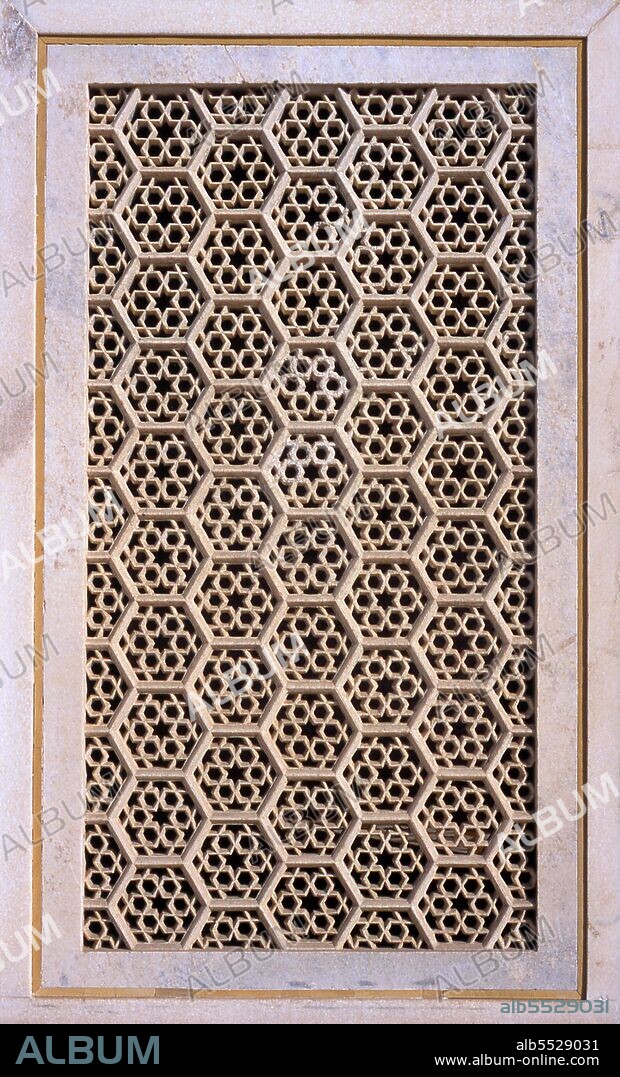alb5529031
India: A jali or latticed stone screen in the tomb of I'timad-ud-Daulah, Agra, Uttar Pradesh.

|
Add to another lightbox |
|
Add to another lightbox |



Title:
India: A jali or latticed stone screen in the tomb of I'timad-ud-Daulah, Agra, Uttar Pradesh.
Caption:
A jali (or jaali, Gujarati ????) is the term for a perforated stone or latticed screen, usually with an ornamental pattern constructed through the use of calligraphy and geometry. Early work was performed by carving into stone, while the later used by the Mughals employed the technique of inlay, using marble and semi-precious stones. Jali typically use Floral geometric patterns. Etimad-ud-Daula's Tomb (Urdu: ?????? ?????? ?? ??????, I'timad-ud-Daulah ka Maqbara) is a Mughal mausoleum in the city of Agra in the Indian state of Uttar Pradesh. Along with the main building, the structure consists of numerous outbuildings and gardens. The tomb, built between 1622 and 1628 represents a transition between the first phase of monumental Mughal architecture - primarily built from red sandstone with marble decorations, as in Humayun's Tomb in Delhi and Akbar's tomb in Sikandra - to its second phase, based on white marble and pietra dura inlay, most elegantly realized in the Taj Mahal. The mausoleum was commissioned by Nur Jahan, the wife of Mughal emperor Jahangir, for her father Mirza Ghiyas Beg, originally a Persian Amir in exile, who had been given the title of I'timad-ud-Daulah (Pillar of the State). Mirza Ghiyas Beg was also the grandfather of Mumtaz Mahal (originally named Arjumand Bano, daughter of Asaf Khan), the wife of the emperor Shah Jahan, responsible for the construction of the Taj Mahal.
Credit:
Album / David Henley/Pictures from History/Universal Images Group
Releases:
Model: No - Property: No
Rights questions?
Rights questions?
Image size:
3086 x 5100 px | 45.0 MB
Print size:
26.1 x 43.2 cm | 10.3 x 17.0 in (300 dpi)
Keywords:
AGRA • ARCHITECTURE • ASIA IMAGES • ASIA PICTURES • ASIA • ASIAN IMAGE • ASIAN IMAGES • ASIAN PICTURES • ASIAN • DAVID HENLEY • ETIMAD-UD-DAULA • FUNERARY • GRAVE • HISTORIA UNIVERSAL • HISTORICAL IMAGES • HISTORICAL PICTURES • HISTORICAL • HISTORY IMAGES • HISTORY PICTURES • HISTORY • I'TIMAD-UD-DAULAH • INDIA • INDIAN • INDIGENOUS PEOPLES OF THE AMERICAS • INDIO • ISLAM • ISLAMIC • ISLAMISM • JAHANGIR • JALI • MARBLE • MARBRE • MAUSOLEO • MAUSOLEUM • MOGHUL • MOGUL • MUGHAL • MUMTAZ MAHAL • MUSLIM WORLD • MUSLIM • RELIGION • SÉPULCRE • SHAH JAHAN • SHAH JEHAN • SHAHJEHAN • TOMB • UTTAR PRADESH
 Pinterest
Pinterest Twitter
Twitter Facebook
Facebook Copy link
Copy link Email
Email
